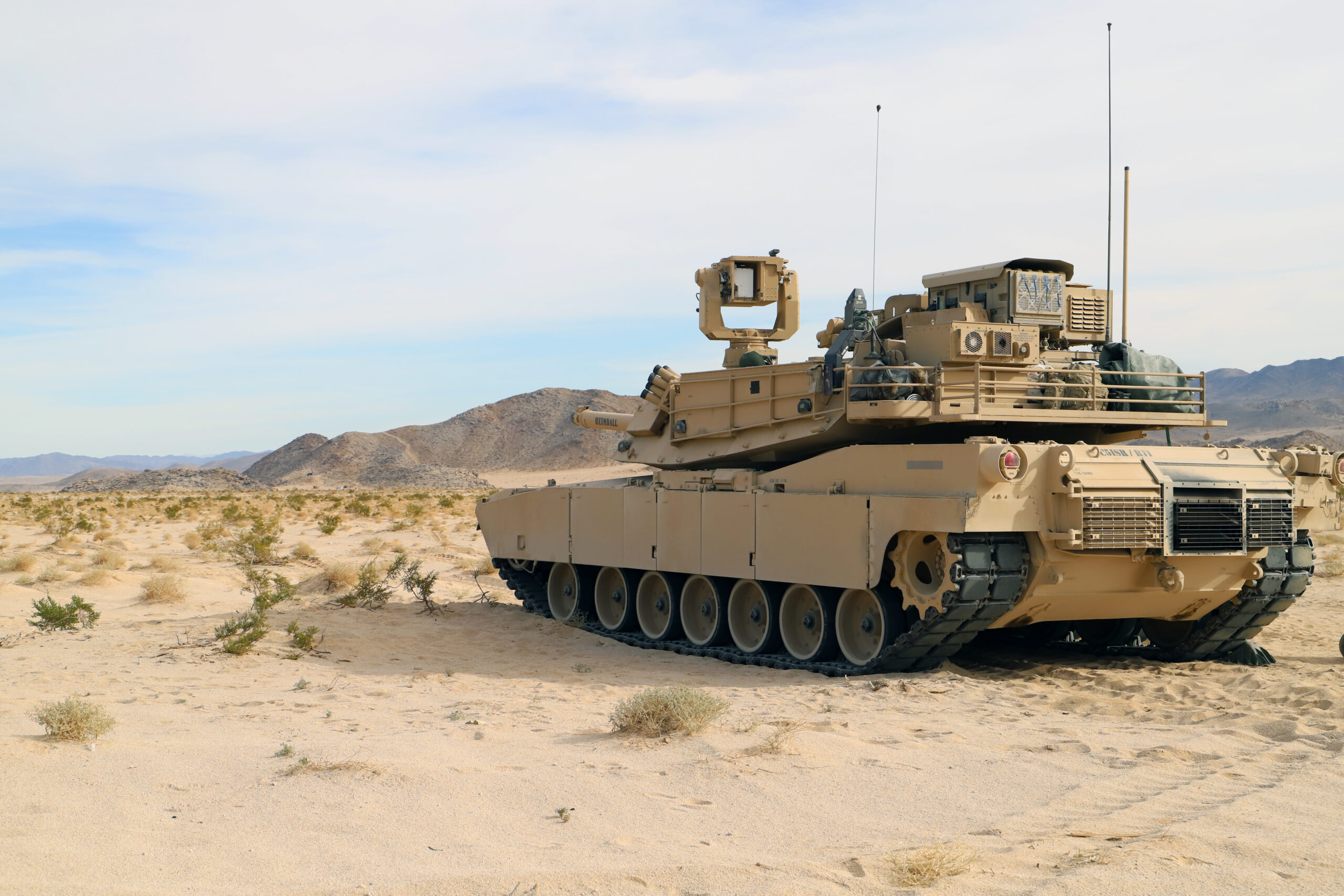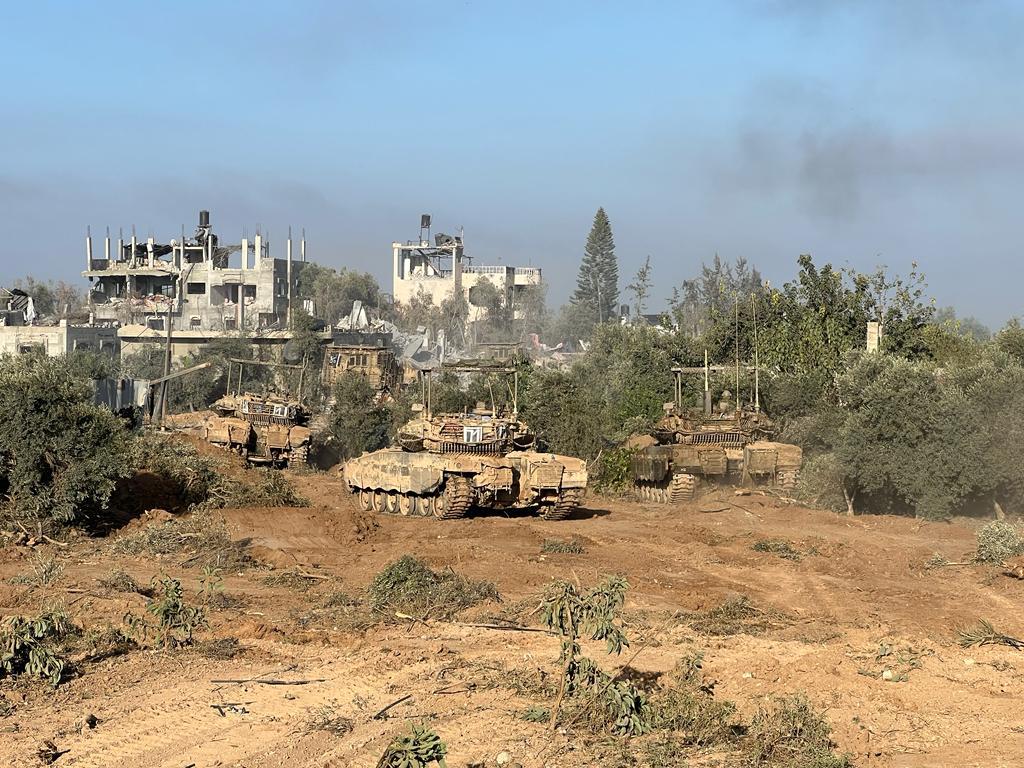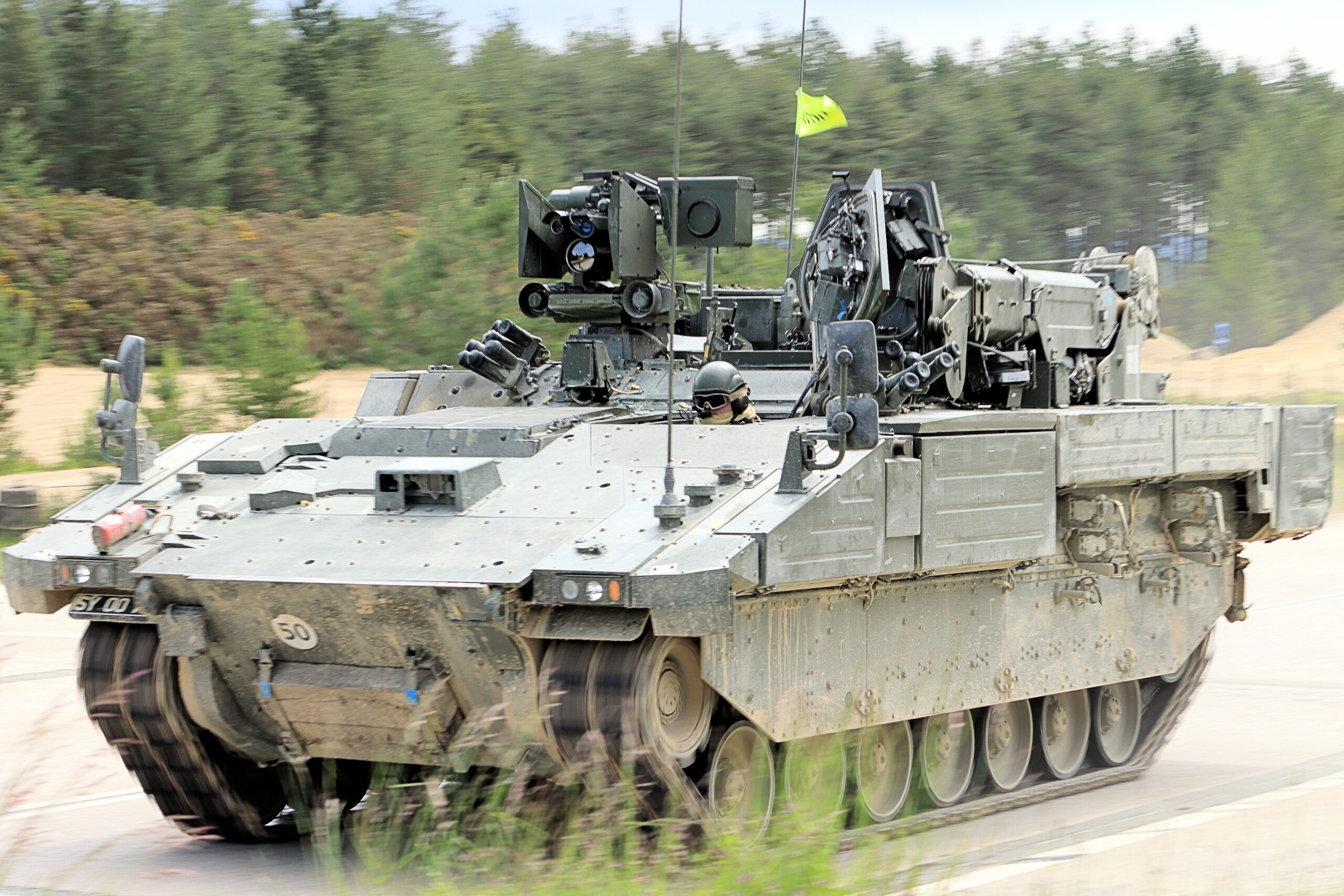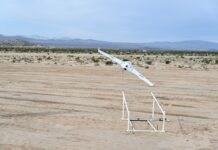Looking out over the next decade, this article aims to identify some of the key trends and requirements which we are likely to see emerge in armoured fighting vehicles (AFVs) of the 2030s and beyond. While predicting the future can often be challenging, examining current trends in industry and on the battlefield can provide a number of useful clues as to the direction future AFV design may take.
The future requirements of armoured fighting vehicle (AFV) design in the next decade will differ from the past 108 years in three key ways. Artificial intelligence (AI) will become a valuable tool to overcome the challenges of dispersion and improve target engagement. Its use will likely grow in tandem with more advanced mission systems that are designed to bring closer coordination between front line units from the air to the sea. Together, they will drive a greater need for edge computing power. The second will be a requirement for a survivability matrix; a combination of protective systems designed from the outset around a variety of threats. Matrices will move away from the traditional front-loading of armour towards affording the vehicle 360° protection from all but the most capable forms of lethality. The third is that future growth will be built into the AFV with software as much as hardware. Software updates will provide more than the reduction in memory and changes to various apps that smartphone users are probably familiar with; it will be able to deliver fundamentally new capabilities, provided that the first point was properly addressed at the outset.
How then, will these changes come about? Why aren’t the next pages filled with comparisons of internal combustion engines against hybrids or conventional large calibre armaments to electromagnetic railguns? The answer to the second point is relatively simple. From a lethality standpoint, there are few targets on the battlefield that cannot be decisively engaged with the current arsenal of weaponry carried by AFVs. For main battle tanks, the 120 mm or 125 mm gun remains capable and very lethal. There is always scope for additional lethality against heavily armoured targets, but if that really becomes necessary, the Rheinmetall 130 mm gun or the Nexter Ascalon 140 mm designs will likely address the shortfall for Western nations.

Credit: Rheinmetall
For infantry fighting vehicles (IFV), the 30 mm cannon remains a formidable weapon that is difficult to defend against without driving vehicle weight up. If a 30 mm cannon is no longer sufficient, the readily-available 40 mm cannons on the market provide a marked increase in lethality without changing manufacturing requirements or – in the case of the 40 × 180 mm ‘Super Forty’ cartridge – the internal layout of the turret. There are lethality gains left on the table in Russia, China and Europe. Russia has developed the 2A91 57 mm cannon that arms its Derivatsiya-PVO air defence vehicle. The UK and France have developed the CT40 cased telescoped weapon system, which arms the EBRC Jaguar and Ajax reconnaissance vehicles. China has a similar development underway, although it has so far only known to have been demonstrated in a static firing position. All of these weapons would be capable of engaging almost any current non-MBT AFV from the front and defeating them at 1,000 m. They would also represent a significant challenge for an MBT from the side.
I know; railguns are exciting, as is Electrothermal-chemical (ETC) technology and the many other options touted as a replacement for conventional munitions. However, the truth is that these systems are fraught with developmental risk. Whilst they may offer lethality increases, they do so with an increase in the likelihood that a programme will fail or be delayed. Few defence departments have the stomach for this in the current climate when the available conventional weapons already meet most needs, and an increase in calibre can meet those that exceed current capabilities. This was true when Professor Ogorkiewicz discussed these technologies in his 2016 book Tanks: 100 years of evolution, and it is true now.
What about mobility? There are exciting possibilities for growth in composite rubber track (CRT) technology, especially if tracks can be produced that will bear MBT-like weights.[1] Benefits include reduced road noise and increased speed, greater track life, reduced weight compared with steel tracks, and lower vibration. These are all good things and will improve the performance and use of tracked AFVs. However, CRTs will be hard-pressed to fundamentally alter AFV mobility off-road. There are efforts underway to explore hybrid electric drives for AFVs that will provide the power for energy-hungry computers and mission systems as well as reducing environmental impact. However, as is the case with CRTs, it is hard to see a way for a hybrid or even fully electric drive train to dramatically alter mobility performance. That is not to say that electrified drive trains will not be elements of future AFV requirements, simply that the onus will be on those manufacturers to prove that these systems can meet the mobility standards set by combustion engines. That said, some form of hybrid drive train will most likely be included in all future Western AFV designs as there is political impetus to do so.
A relatively reserved assessment of the prospects for AFV mobility is also necessary because much of a vehicle’s ability to move over any terrain is shaped by physics and the interaction of a tyre or track with soil, rock, sand, or road. The heavier the vehicle, the more difficult it will be to guarantee mobility on wet soil, or in a town with weak and dilapidated infrastructure. There is very little that can be done to alter this from a drive train or track perspective when so much is decided by a vehicle’s weight and size.
A shift in mindset?
What will drive the AFV design requirements of the next two decades? With the exception of countering IEDs in Iraq and Afghanistan, many western AFV developments since 1990 have been capability-, as opposed to threat-driven. Manufacturers made suggestions for vehicle designs based on what was technically possible, and what the user thought they might want or need. This attitude is shifting to focus more on the threats that an armed force must counter, in part because those threats have changed significantly. Take ATGMs as an example; they were relatively rare until the Syrian Civil war started in 2011 and Iran, Russia, and the US began arming their preferred allies in the region with some of their best weapons.[2] The weapons found their way into use with ISIS, and now the Houthis in Yemen are experienced users, as are Hezbollah and Hamas. ATGMs are here to stay and pose a considerable threat to current and future AFVs.

Credit: US Army
The use of small drones in combat has evolved, again since around 2011. Their use in Ukraine has brought drones into the limelight, but they were used extensively in Iraq and Syria by ISIS.[3] The ability of small drones to damage AFVs at the asymmetric end of combat must also be considered alongside the lethality of loitering munitions such as Russia’s Lancet-3M and armed drones carrying ATGMs at the peer-conflict end. A small drone modified to carry a grenade or fly an RPG warhead into a vehicle is limited by its own payload. Weapons developed by states typically carry warheads that approach the capabilities of an ATGM, making them a more potent if less common threat.
Outside of these technological threats, there is the very real prospect of state-on-state conflict. European states must consider how they will deter Russia. The US must prepare its armed forces to counter China and what role its AFVs will be required to play in the Indo-Pacific. It appears that many NATO states have lost their appetite for wars of choice in the Iraq/Afghanistan vein. However, if the current fleets of AFVs are indicative of service life, then AFVs designed in the next decade or two, should expect to serve into – or close to – the next century. Because of this, urban warfare against an asymmetric opponent is almost a certainty.
Overall, the AFV designs of the future must contend with a greater variety of threats than ever. On the one hand designers will need to revisit Cold War threats such as top attack sensor fuzed munitions, or extensive minefields with high density mine patterns, as well as the immense challenge of stopping the APFSDS rounds fired by Russian and Chinese guns. On the other hand, those same vehicles will have to be capable of resisting the effects of ATGMs that are more accurate and lethal than ever, and the omnipresent threat of small drones carrying explosives and munitions against the traditionally vulnerable upper arc of an AFV. They will be required to do all of this and more in urban environments, which increase the need for 360° passive armour. Additionally, those designers will be addressing all of this inside the same constraints as the designers of the many World War II tanks; protection, mobility, and firepower. Each adjustment to one of these elements will have an impact on another. However, in line with the changing threat landscape there are emerging technologies that will enable designers to address these threats without building a modern-day equivalent of Nazi Germany’s Maus.
A survivability matrix
This connects neatly with the first element of future AFV requirements that is almost certain to reflect a real change and growth from past design requirements and that is the survivability matrix. Future AFV requirements will require the combination of passive and reactive armour in many cases, with an active protection system (APS) capable of data sharing with other vehicles, upper-hemisphere protection, and a mission system suite that boosts situational awareness. Combining all of these protective systems into a single matrix will provide greater survivability against ATGMs and shoulder-fired anti-tank weapons as well as drone-delivered munitions. Furthermore, it will extend protection through vehicles automatically supporting each other and enabling engagements to take place at greater range.
Many vehicles are fitted with an APS, from the Trophy that protects Merkava Mk 4 to the Abrams M1A2 SEP v3, to the Rheinmetall StrikeShield that can be fitted to vehicles such as Boxer, which uses effectors located around the vehicle that are integrated into passive armour blocks. Following tests[4], the US Army also plans to equip a brigade of Bradley IFVs with the Elbit Iron Fist Light Decoupled APS by 2025.[5]

Credit: IDF
However, in most cases the APS is retrofitted to these platforms with knock-on effects for its balance or the turret drives. There are also compatibility issues that result from the interception efficiency of the APS. If the projectile creates by-products (such as fragments) upon interception, the vehicle requires a certain level of base armour to withstand and absorb those by-products. If the armour is too light, then the projectile may still have an impact upon the vehicle and crew. This could be accounted for in the design of the vehicle by installing the APS as part of the vehicle’s construction from the start. Hanwha took this approach in the design of its Redback IFV that was selected by Australia for its Land 400 Phase 3 programme in 2023.[6]
A built-in APS allows other design decisions that can improve protection. For example, if the efficiency and magazine depth of the APS are considered sufficient, a manufacturer can choose to design the vehicle armour only around kinetic energy threats. At present, most AFVs must balance kinetic energy (KE) threats such as armour piercing fin stabilised discarding sabot rounds (APFSDS) with chemical energy threats – otherwise known as high explosive anti-tank (HEAT) or shaped charge threats. Theoretically, both defeat a vehicle using kinetic energy, and both derive their kinetic energy from a chemical energy source, but HEAT rounds generate that energy at the point of activation. It is possible to balance the armour of a vehicle to withstand both, but not optimal. For example, explosive reactive armour (ERA) designed to counter HEAT projectiles will employ a thinner flyer plate that disrupts and destabilises the jet. The same armour designed for a large calibre APFSDS will need to employ a much heavier and thicker flyer plate that transfers stress to the projectile, as well as moving additional armour into its path.
So, if an APS can be considered sufficiently capable to defend against HEAT threats, the armour of choice could be focused on KE and optimised to defend against it. Or, if an APS can successfully intercept an APFSDS round, as demonstrated by Elbit with their Iron Fist Light Kinetic in 2020, the passive armour could be reallocated to provide greater protection to all sides of the vehicle and improve its survivability in urban environments.[7] This design approach could serve to drive vehicle weights down, or return designs to weights that are more easily supported.[8] One further element to consider is the role of modular APSs. The UK’s DSTL is exploring this through the Modular Integrated Protection System architecture, which is designed to demonstrate the ability of proven technologies and capabilities to be integrated into an APS.[9] It includes software and hardware, and the programme is exploring the possibility of sensor fusion and data sharing between APSs. If successfully developed, this could provide vehicles with an element of upper-hemisphere protection from drones and munitions. Sensor fusion and data sharing between platforms might even allow for a greater warning time of an approaching drone or loitering munition.
What of artificial intelligence?
At a conference in 2023, one US attendee told this author, ‘Your senior officers seem to sprinkle AI over everything like it will fix all of their problems.’ He was not wrong in his assessment, discussion of the role of AI in defence often lacks any real-world explanation of how it can help. For AFVs there is one clear use case that is already viable, but will become more so in the near future, and that is sensor fusion. Sensor fusion is not the latest buzzword, it is a real thing that is already practised by commercial companies. The most prominent use case is in driverless vehicles, which must fuse data from LIDAR, cameras, and radars to form a single unified image of the environment around the vehicle so that its computers can make better decisions.[10] The use case for AFVs is much the same, however, humans are required to make the decisions.
A driving factor in this development is the role of dispersion in modern warfare. From Afghanistan to Ukraine, armed forces are being dispersed over much larger areas than they would normally contest. It is not uncommon to see Ukrainian trenches defended by two or three personnel, for instance. The dispersion and distance between units generates a demand for more ISR assets so that the dispersed units can understand the world around them and the space between them and their nearest friendly unit. However, this in turn leads to many different pictures of the battlefield and difficulty in sharing that data between units.
Sensor fusion enabled by AI could help address this need in future AFVs. Sensor fusion algorithms work by taking data processed on one sensor – on a drone for example – and sending it to another platform. This is known as decentralised sensor fusion and requires additional computing power deployed to edge platforms.[11] Furthermore, providing an AFV with its own edge computer capable of running sensor fusion AI offers future benefits; AI can be used to track objects and their trajectory to provide more accurate fire control solutions.

Credit: Norwegian MoD
Put simply, sensor fusion at the edge of the battlefield would enable one vehicle to detect a tank moving across the front and pass data about that vehicle to another platform that cannot see it. Upon detecting that tank the second vehicle’s computers would recognise the vehicle and update its situational awareness to reflect it as the same vehicle. In current environments it is not uncommon for one tank observed by two different vehicles to be reported as two tanks, for example. This appears to be the goal of the Thales Combat Digital Platform, which uses AI to fuse data inputs from a variety of sensors and present it to all echelons.[12]
Theoretically, this concept could be taken further to allow platforms across domains to cooperate and share data. It was taken to an extreme by the US Army under Project Convergence; one trial involved space-based sensors providing targeting data to a modified howitzer through AI-enabled data centres.[13] In other trials, AI has helped coordinate air defence engagements between ground-based Patriot batteries and F-35s.[14] The US developments in the field of AI as a tool to improve data sharing between disparate platforms and improve target engagements is indicative of what might be possible for future AFV designs. However, it is essential that sufficient computing power that is built for AI is a part of future AFV requirements, otherwise this potential will not be realised.
Software defined defence
Most modern combat systems are already heavily dependent on software, 80% of the F-22’s functions are performed by software, for instance.[15] The F-22 entered service in 2000, so why is software referenced here as an element in future AFV design requirements? Firstly, AI requires software, it provides the user interface that the operator interacts with and is a significant part of how effectively an algorithm can be used. Secondly, many subsystems within the defence world are also software defined, from engines to sights. This is driven in no small part by the world’s shift towards software defined systems as a whole; this article was written on a software defined network infrastructure. Many people now carry watches that are software defined, instead of the mechanical mechanisms that have made watches work for the past century.
Often these software systems fail to offer a new capability. A digital heating system is marginally more convenient than a conventional thermostat, but it ultimately turns the heating on and off, sometimes remotely. However in AFVs, it would be possible to build new capabilities into a platform through software updates. For instance, a link between the vehicle’s battle management system and a supporting drone could be created, allowing the vehicle crew to benefit from the drone’s enhanced viewpoint. Expanding this concept, software is essential to the networked systems of systems envisaged by most Western forces. It was key to the air defence and indirect fires examples in the previous section. Through application programming interfaces (APIs) different platforms can be connected and empowered with AI and greater computing power to share and understand more data than ever. Again, APIs are not new, APIs in AFVs are not entirely new.[16] However, harnessing the growth and miniaturisation of computing power, along with relatively recent developments in neural networks and AI provide new opportunities to AFV designers. The requirement for AFV designers is that a vehicle should have a genuinely open system architecture with customer-defined and owned APIs.
This allows any selected company to develop software to upgrade the vehicle’s systems. The possibilities are considerable; a vehicle could be purchased in a relatively simple configuration, with automated target detection added at a later date when it is considered sufficiently evolved by the user. New types of vehicles and drones could be introduced into service and connected to the AFV fleet through software. A vehicle’s targeting algorithms could be updated to allow for engaging a new type of target or responding to changes in target behaviour. General Dynamics UK had embraced this concept with Ajax in 2019, however, the ensuing challenges with the vehicle’s maturation has obscured this.[17]

Credit: Airwolfhound from Hertfordshire, UK, via Wikimedia Commons
Nevertheless, a move towards software defined AFVs is underway. Together with AI, software is critical to concepts such as manned-unmanned teaming that the US and others have identified as definitive in future warfare. Consider, for example, the impact that a completely autonomous drone providing target data to a fleet of AFVs and supporting fire assets could have.
In sum
You may realise that much of what has been discussed above is already emerging within the current generation of AFVs. The AbramsX is slated to carry AI-enabled command and control (C2), an unmanned turret, and the ability to deploy and operate drones.[18] The KNDS Main Ground Combat System pursues similar concepts, and even the Russian T-14 Armata claimed to have many of these capabilities.[19] There are in-service vehicles with these capabilities so, how are they the requirements of future AFV designs? Put simply, the three requirements identified here represent the author’s assessment of what will be definitive, as opposed to marginal, in their ability to improve combat outcomes.
Bigger guns and more advanced ammunition can be fitted to AFVs, but the capacity to do so is finite. A 140 mm gun has been fitted and test-fired on a Leclerc hull, but the video footage of it firing does not suggest that it is necessarily an optional solution.[20] A 130 mm gun is more viable, but as stated above, the current lethality of AFVs is quite considerable and already addresses most threats. Equally, mobility is undergoing some modernisation through hybrid propulsion and smaller powerpacks delivering like-for-like capability at a smaller footprint and total weight. This allows reductions in vehicle weight and armoured volume, but does not change the properties of soil. It might lead to an MBT with improved off-road mobility compared with the 70-tonne monster it replaced, but it will not lead to fundamentally new off-road performance that cannot already be achieved by something akin to a CV90.
However, a survivability matrix that is built from the ground up to be modular and include an APS will greatly enhance the ability of an AFV to survive and fight in future wars. Enhanced with AI and advanced sights, the crew will theoretically be able to understand their environment to a greater extent than any of their predecessors whilst sharing their understanding with a network of other platforms that is only limited by the range and bandwidth of its communications network, and the computing power that they carry. All of these elements combined would potentially represent a significant shift in how AFVs fight, and the impact that they can have on a battlespace.
There is one final element to address, which is the question of unmanned elements: unmanned turrets, unmanned ground vehicles, and so on. These have not been addressed as separate entities because it is not possible to have an autonomous unmanned ground vehicle without AI and enormous computing power. While they may be considered ‘expendable’, the cost of developing these platforms to a standard where a Western force would be content to deploy them is likely such that they will be similarly protected to their crewed partners.
So, in sum, these are the three areas that this author believes will represent a fundamental shift in how AFVs are designed and how they operate. Everything else is of course important; you can’t have a tank without tracks and a big gun, no matter what some might think. Yet in the quest to attain an advantage over opponents, and competitor manufacturers, it will be the designs that harness AI, software, and layered survivability matrices to the fullest extent that gain the edge.
Sam Cranny-Evans
Endnotes
[1] https://www.tanknology.co.uk/post/__crt
[2] https://www.moore.army.mil/armor/earmor/content/issues/2016/jan_mar/1Trujillo_Adkinson16.pdf
[3] https://edinburghuniversitypress.com/book-how-isis-fights.html
[4]https://www.dote.osd.mil/Portals/97/pub/reports/FY2022/army/2022aps.pdf?ver=rNoujZUlPp4ID3p01RsLwQ%3D%3D
[5]https://www.army.mil/article/263069/army_announces_improved_test_results_in_lightweight_active_protection_systems
[6] https://euro-sd.com/2023/07/news/33076/as21-redback-emerges-victorious-in-australias-land-400-phase-3-ifv-contest/
[7] https://www.janes.com/defence-news/news-detail/iav-2020-elbits-iron-fist-engages-kinetic-energy-round#
[8] https://www.forces.net/technology/land-vehicles/challenger-3-why-its-weight-might-be-problem-war
[9] https://www.gov.uk/government/news/icarus-advances-armoured-vehicle-protection
[10] https://www.aptiv.com/en/insights/article/what-is-sensor-fusion
[11] https://www.thinkautonomous.ai/blog/9-types-of-sensor-fusion-algorithms/
[12] https://www.thalesgroup.com/en/worldwide/defence/press_release/thales-takes-collaborative-combat-new-level-combat-digital-platform
[13] https://breakingdefense.com/2020/08/army-tests-new-all-domain-kill-chain-from-space-to-ai/
[14] https://news.northropgrumman.com/news/releases/us-army-ibcs-flight-test-demonstrates-joint-engagement-in-electronic-attack-environment
[15] https://www.iiss.org/globalassets/media-library—content–migration/files/research-papers/iiss_software-defined-defence_17022023.pdf
[16] https://apps.dtic.mil/sti/pdfs/ADA393806.pdf
[17] https://static.rusi.org/EI-Ajax-052022.pdf
[18] https://warriormaven.com/land/army-next-generation-abrams-tanks-2030-abramsx; https://euro-sd.com/2022/10/news/27594/abramsx/
[19] https://euro-sd.com/2023/01/articles/29122/main-ground-combat-system-mgcs-a-status-report/; https://euro-sd.com/2022/12/articles/28414/future-main-battle-tanks/







![MGCS status update The KNDS EMBT-ADT 140 technology demonstrator on display at the Eurosatory 2024 exhibition. This model featured the 140 mm configuration of the ASCALON gun. [Mark Cazalet]](https://euro-sd.com/wp-content/uploads/2025/08/EMBT-EDT-140_Mark-Cazalet-Kopie-218x150.jpg)

![Key programmes bolster Türkiye’s defence-export boom Secretary of the SSB, Prof. Dr. Haluk Görgün, said that Türkiye was building a “ground-breaking ecosystem in technology exports for the future”. [TiM]](https://euro-sd.com/wp-content/uploads/2025/07/2-Prof-Dr-Haluk-Gorgun-Jan-2025-Credit-TiM-Kopie-218x150.jpg)



